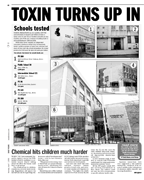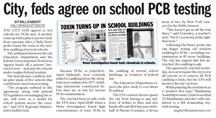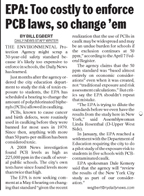(click for pdfs)

 The
Daily News tested caulking sampled from several NYC public schools
and found that most contained many times more PCBs than the threshold
for toxic waste. Polychlorinated
biphenyls were banned for most uses in 1979 after being
linked to cancer, severe birth defects and broad ecological damage.
For decades before the ban, however, PCBs were routinely
added to the caulking used in most large buildings built since the
1950s. Under EPA regulations established 30 years ago,
anything with more than 50
parts-per-million of PCBs
is considered toxic waste, demanding immediate
removal and disposal at a proper hazmat facility.
The
Daily News tested caulking sampled from several NYC public schools
and found that most contained many times more PCBs than the threshold
for toxic waste. Polychlorinated
biphenyls were banned for most uses in 1979 after being
linked to cancer, severe birth defects and broad ecological damage.
For decades before the ban, however, PCBs were routinely
added to the caulking used in most large buildings built since the
1950s. Under EPA regulations established 30 years ago,
anything with more than 50
parts-per-million of PCBs
is considered toxic waste, demanding immediate
removal and disposal at a proper hazmat facility.
I found 225,000ppm
in the caulking of one Upper West Side elementary school.
Ironically, this school had just had most of its windows replaced --
but using a method that spread PCB-laden dust throughout the school.
During the work, teachers complained that students had to
wipe
down their desks every day.

 After
reading my initial coverage, a mother on Staten
island
decided to test the a HEPA filter she had placed in
her
asthmatic son's classroom. In two weeks of use,
the filter
had
collected PCBs far beyond
the 50ppm limit. This was a year after the
school's windows were removed by the same method as the Manhattan
school. PCBs started turning up in a lot of schools.
As of September 2009, the count was 85 schools
with illegal
levels of PCBs in the caulking, with the highest
concentration at 470,000ppm.
After
reading my initial coverage, a mother on Staten
island
decided to test the a HEPA filter she had placed in
her
asthmatic son's classroom. In two weeks of use,
the filter
had
collected PCBs far beyond
the 50ppm limit. This was a year after the
school's windows were removed by the same method as the Manhattan
school. PCBs started turning up in a lot of schools.
As of September 2009, the count was 85 schools
with illegal
levels of PCBs in the caulking, with the highest
concentration at 470,000ppm.

 The
ensuing City Council hearings
and lawsuits
finally
resulted in a settlement
in January 2010 between the EPA and the city to deal with the
PCB
caulking in what they billed as a national model. The
problem isn't unique to New York by any means -- nor, quite frankly,
limited to schools. PCBs in legacy caulking persist in many instutional
buildings across the country built between 1950 and 1977.
The
ensuing City Council hearings
and lawsuits
finally
resulted in a settlement
in January 2010 between the EPA and the city to deal with the
PCB
caulking in what they billed as a national model. The
problem isn't unique to New York by any means -- nor, quite frankly,
limited to schools. PCBs in legacy caulking persist in many instutional
buildings across the country built between 1950 and 1977.
 More
recently, in a surprise about-face, the EPA has proposed changing its regulations
to exempt caulking from the 50ppm safety standard. Oddly, it
was embedded in a much larger
proposal
to tighten regulations on electrical equipment containing PCBs,
simultaneously arguing that 50ppm is dangerous inside sealed
capacitors, but thousands of times that amount might be just fine on
classroom window sills. It wasn't an easy sell at the Manhattan public hearing.
More
recently, in a surprise about-face, the EPA has proposed changing its regulations
to exempt caulking from the 50ppm safety standard. Oddly, it
was embedded in a much larger
proposal
to tighten regulations on electrical equipment containing PCBs,
simultaneously arguing that 50ppm is dangerous inside sealed
capacitors, but thousands of times that amount might be just fine on
classroom window sills. It wasn't an easy sell at the Manhattan public hearing.
Back to Main Page

 The
Daily News tested caulking sampled from several NYC public schools
and found that most contained many times more PCBs than the threshold
for toxic waste. Polychlorinated
biphenyls were banned for most uses in 1979 after being
linked to cancer, severe birth defects and broad ecological damage.
For decades before the ban, however, PCBs were routinely
added to the caulking used in most large buildings built since the
1950s. Under EPA regulations established 30 years ago,
anything with more than 50
parts-per-million of PCBs
is considered toxic waste, demanding immediate
removal and disposal at a proper hazmat facility.
The
Daily News tested caulking sampled from several NYC public schools
and found that most contained many times more PCBs than the threshold
for toxic waste. Polychlorinated
biphenyls were banned for most uses in 1979 after being
linked to cancer, severe birth defects and broad ecological damage.
For decades before the ban, however, PCBs were routinely
added to the caulking used in most large buildings built since the
1950s. Under EPA regulations established 30 years ago,
anything with more than 50
parts-per-million of PCBs
is considered toxic waste, demanding immediate
removal and disposal at a proper hazmat facility. 
 After
reading my initial coverage, a mother on Staten
island
decided to test the a HEPA filter she had placed in
her
asthmatic son's classroom. In two weeks of use,
the filter
had
collected PCBs far beyond
the 50ppm limit. This was a year after the
school's windows were removed by the same method as the Manhattan
school. PCBs started turning up in a lot of schools.
As of September 2009, the count was 85 schools
with illegal
levels of PCBs in the caulking, with the highest
concentration at 470,000ppm.
After
reading my initial coverage, a mother on Staten
island
decided to test the a HEPA filter she had placed in
her
asthmatic son's classroom. In two weeks of use,
the filter
had
collected PCBs far beyond
the 50ppm limit. This was a year after the
school's windows were removed by the same method as the Manhattan
school. PCBs started turning up in a lot of schools.
As of September 2009, the count was 85 schools
with illegal
levels of PCBs in the caulking, with the highest
concentration at 470,000ppm.
 The
ensuing City Council hearings
and lawsuits
finally
resulted in a settlement
in January 2010 between the EPA and the city to deal with the
PCB
caulking in what they billed as a national model. The
problem isn't unique to New York by any means -- nor, quite frankly,
limited to schools. PCBs in legacy caulking persist in many instutional
buildings across the country built between 1950 and 1977.
The
ensuing City Council hearings
and lawsuits
finally
resulted in a settlement
in January 2010 between the EPA and the city to deal with the
PCB
caulking in what they billed as a national model. The
problem isn't unique to New York by any means -- nor, quite frankly,
limited to schools. PCBs in legacy caulking persist in many instutional
buildings across the country built between 1950 and 1977. More
recently, in a surprise about-face, the EPA has proposed changing its regulations
to exempt caulking from the 50ppm safety standard. Oddly, it
was embedded in a much larger
proposal
to tighten regulations on electrical equipment containing PCBs,
simultaneously arguing that 50ppm is dangerous inside sealed
capacitors, but thousands of times that amount might be just fine on
classroom window sills. It wasn't an easy sell at the Manhattan public hearing.
More
recently, in a surprise about-face, the EPA has proposed changing its regulations
to exempt caulking from the 50ppm safety standard. Oddly, it
was embedded in a much larger
proposal
to tighten regulations on electrical equipment containing PCBs,
simultaneously arguing that 50ppm is dangerous inside sealed
capacitors, but thousands of times that amount might be just fine on
classroom window sills. It wasn't an easy sell at the Manhattan public hearing.